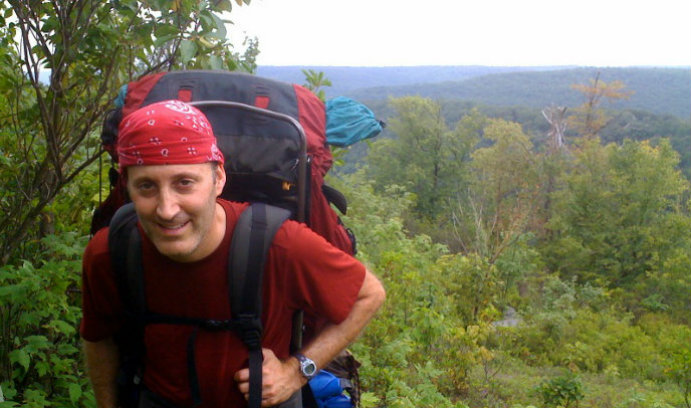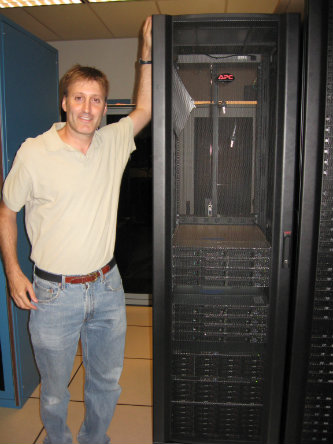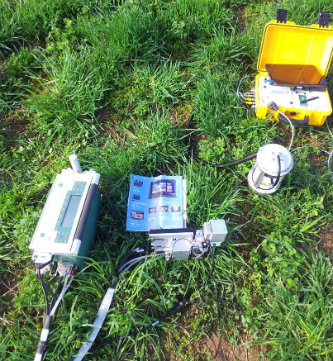Climate models, carbon and cows

Benjamin Felzer, assistant professor of earth and environmental sciences, backpacking the Black Forest Trail in north central Pennsylvania.
“I’m objective as a scientist, so it makes me a little different from an activist,” says Benjamin Felzer, assistant professor of earth and environmental sciences. “But I think [climate change] is something that I wish we would be more serious about dealing with. The changes are there in the data. We know we’ve contributed to the warming of the Earth.”
Felzer’s research provides information about the potential consequences of that warming on particular terrestrial ecosystems and the many resources we get from them: food, fiber and fuel.
Climate scientists use mathematical models and plausible scenarios to examine changes in climate variables as well as the effects of these changes. In September 2014, Felzer and Dork Sahagian, director of Lehigh’s Environmental Initiative, published a paper in the environmental journal Climate Research in which they used the data from a broad range of climate models to determine significant trends among them. Policymakers can consider these trends as more likely scenarios for their particular geographical regions.
“We were looking at the issue of how climate change is going to affect different regions of the U.S. and the ecosystem consequences, in particular ecosystem services,” says Felzer. “An important part of this study was to assess where there was model agreement and disagreement and where the trends were statistically significant or not across different seasons and different regions of the U.S.”
Felzer and Sahagian used a variety of climate models from around the world along with three different scenarios from the Fourth Assessment Report (AR4) of the Intergovernmental Panel on Climate Change (IPCC), a United Nations-governed body of scientific experts that coordinates climate projections of the future amongst the world’s leading climate modeling centers. Felzer and Sahagian then entered the climate model data into Felzer’s version of a biogeochemical model, a terrestrial ecosystem model called TEM-Hydro.
A terrestrial ecosystem model is a model of vegetation and soils and the flow of carbon and nitrogen and water between them. Factors such as surface temperature, precipitation, solar radiation, humidity and carbon dioxide determine how ecosystems operate and therefore force the model. The model outputs are ecosystem services including water runoff, evapotranspiration, net primary productivity, net ecosystem productivity and crop yield. The use of TEM-Hydro allowed Felzer and Sahagian to zero in on outputs for different geographic regions.
Felzer and Sahagian found that there are some significant region-specific trends. In the northern United States, for example, runoff is simulated to increase in winter and decrease in summer, and snowpack is reduced everywhere. Precipitation showed few significant projected trends; however, precipitation is a driver for variables such as soil moisture, which showed significant trends in many regions. This discovery prompted Felzer and Sahagian to look beyond the data at face value.
“You need to look at the consequences—the ecosystem impacts—and not just the climate drivers to really determine what’s significant or not,” says Felzer. “[If] the driver’s not showing significant change, maybe what you have to look at is not just the driving factor like rainfall but the consequence of it, because the consequence may be significant and certainly there’s a process. It’s that process of increased rainfall that causes increased runoff. Even if the trend [in rainfall] is not statistically significant, the trend in runoff may be statistically significant.”
“The most fundamental result [of the study] is that global climate models can be used to drive ecological models [like TEM] to reveal responses and trends at regional scales that are not resolvable by the climate models themselves,” says Felzer.
Felzer also published a paper with Bruce Hargreaves, associate professor of earth and environmental sciences, and two graduate students in the journal Crop Science. This study also utilized TEM-Hydro, but this time Felzer and his colleagues sought to more realistically report humid pastureland dynamics under a changing climate.
Before Felzer’s study, the best data set available for pasture lands was from the Konza Prairie Biological Station in Kansas, a region with a far drier climate that that of Pennsylvania.
“Dairy farms are a significant part of the landscape, in Pennsylvania especially,” says Felzer. “[But the Konza Prairie] model didn’t apply to Pennsylvania well.”
Over the course of a year, graduate students Mingkai Jiang and Jien Zhang visited the Rodale dairy farm in Kutztown a couple of days per month to take soil cores and samples of plant material, as well as multiple measurements of leaf photosynthesis, leaf respiration and soil respiration. The team used the resulting data to calibrate TEM-Hydro properly for a Pennsylvania dairy farm.
Felzer and his colleagues then compared the results from the Rodale calibration to the Konza Prairie calibration. They found that Pennsylvania dairy farms are more sensitive to changes in climate when using the Rodale calibration than when using the calibration from Kansas, the drier site.
“If you were doing a global study you might want to use one set of parameters [Konza Prairie] if you’re in a dry-climate pasture and another set of parameters [Rodale] if you’re in a humid dairy farm and that would give you a more realistic assessment of how pasture would change under a changing climate,” says Felzer.
Felzer is currently looking at the effect of both human and natural disturbance on the carbon cycle. Levels of carbon dioxide, the most significant human-controlled greenhouse gas, have risen considerably since the start of the Industrial Revolution.
Most climate models assume mature forests, which tend to be carbon neutral. However, flux towers, which measure carbon emissions from ecosystems, indicate that U.S. forests act as a significant carbon sink—they take in more carbon than they give off. Most climate models also don’t take into account the impact of disturbances such as conversion to agriculture, agricultural abandonment, timber harvest, fire, tropical storms and hurricanes, all of which affect forest age and their role in the carbon cycle. Felzer believes that introducing disturbance into the models will provide a more realistic forest stand age and offer a better sense of the state of the carbon cycle in the United States.
In the end, trees play a role we can’t afford to ignore.
"Ultimately, land use change and disturbance are important because a tree cares more about a chainsaw than a few degrees of warming," says Felzer.
Story by Kelly Hochbein
Posted on:



